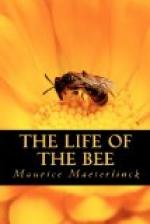These triongulins are the primary larvae of a parasite proper to a wild, obtuse-tongued, solitary bee, the Colletes, which builds its nest in subterranean galleries. It is their habit to lie in wait for the bee at the approach to these galleries; and then, to the number of three, four, five, or often of more, they will leap on her back, and bury themselves in her hair. Were the struggle of the weak against the strong to take place at this moment there would be no more to be said, and all would pass in accordance with universal law. But, for a reason we know not, their instinct requires, and nature has consequently ordained, that they should hold themselves tranquil so long as they remain on the back of the bee. They patiently bide their time while she visits the flowers, and constructs and provisions her cells. But no sooner has an egg been laid than they all spring upon it; and the innocent colletes carefully seals down her cell, which she has duly supplied with food, never suspecting that she has at the same time ensured the death of her offspring.
The cell has scarcely been closed when the triongulins grouped round the egg engage in the inevitable and salutary combat of natural selection. The stronger, more agile, will seize its adversary beneath the cuirass, and, raising it aloft, will maintain it for hours in its mandibles until the victim expire. But, while this fight is in progress, another of the triongulins, that had either no rival to meet, or already has conquered, takes possession of the egg and bursts it open. The ultimate victor has therefore this fresh enemy to subdue; but the conquest is easy, for the triongulin, deep in the satisfaction of its pre-natal hunger, clings obstinately to the egg, and does not even attempt to defend itself. It is quickly despatched; and the other is at last alone, and possessor of the precious egg it has won so well. It eagerly plunges its head into the opening its predecessor had made; and begins the lengthy repast that shall transform it into a perfect insect. But nature, that has decreed this ordeal of battle, has, on the other hand, established the prize of victory with such miserly precision that nothing short of an entire egg will suffice for the nourishment of a single triongulin. So that, as we are informed by M. Mayet, to whom we owe the account of these disconcerting adventures, there is lacking to our conqueror the food its last victim consumed before death; and incapable therefore of achieving the first stage of its transformation, it dies in its turn, adhering to the skin of the egg, or adding itself, in the sugary liquid, to the number of the drowned.
[78]




